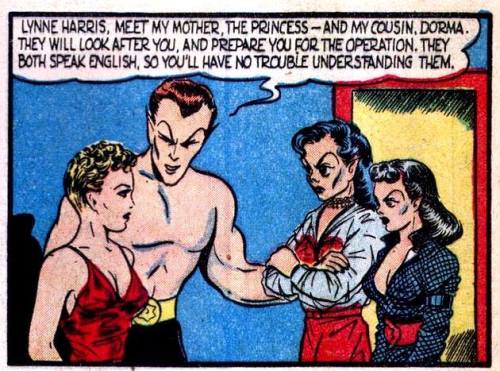#bill everett
In January of 1977, I turned ten-years-old. And around that time, I would up getting my second book collection of vintage comic book stories–a book that, up until that point I didn’t even know existed. We found it in the remaindered section at Two Guys, a regional low-rent department store chain, kind of like the K-Mart of its day. And because I had money that had been given to me for my birthday, I was able to buy it. By that point, it was twelve years old and had gone through several printings–it was, in fact, the very first collection of vintage comic book stories ever published, coming out in 1965 just ahead of the Batman TV show craze.
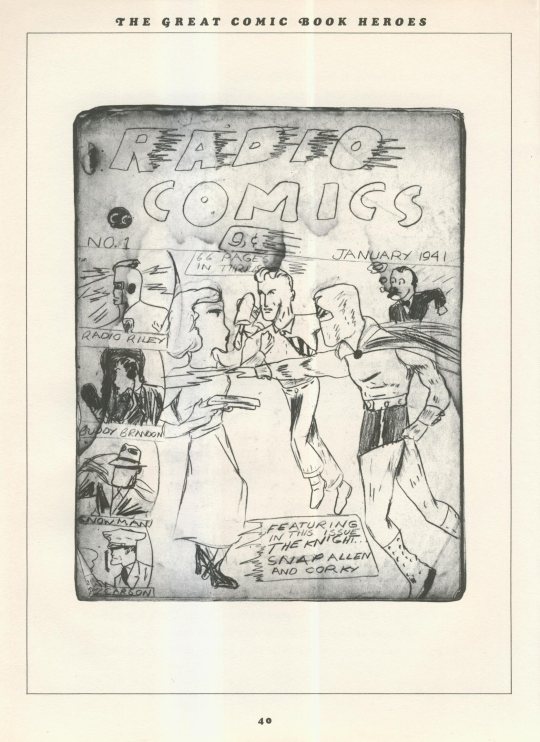
THE GREAT COMIC BOOK HEROES began life as an article that Jules Feiffer had written for Playboy magazine, of all places. It was a nostalgic look back, warts and all, at the comic books that were a part of his youth and the state of the industry a few years later when he was able to get into the business working for Will Eisner. From there, Feiffer went on to be a successful syndicated cartoonist, his strip primarily appearing in the Village Voice, as well as an accomplished playwright. He was so well-regarded, in fact, that he was able to convince a number of publishers to reprint stories from their back catalog in this hardcover collection–publishers who, up to this point, has never really worked in concert before.
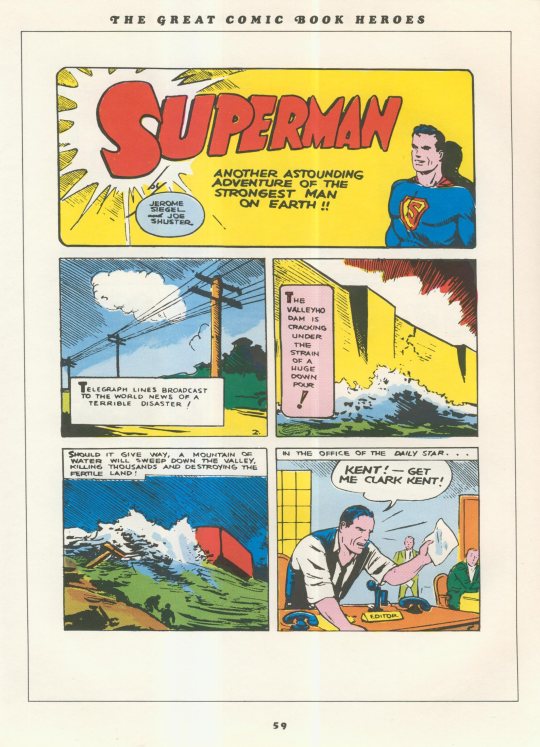
As no good reproduction materials existed, Feiffer worked in concert with DC’s Jack Adler to pioneered a process by which old comic books could be photographed under certain conditions to create a usable black line image, and then recolored. This same process was later used on many of DC’s reprints, in particular the FAMOUS 1st EDITION treasuries–I gather that the reason its use wasn’t more widespread is that it was more costly and time-consuming than was considered worthwhile for a regular comic book release.

Feiffer was also enough of a bigwig in 1965 that he was able to negotiate a minor detente in the legal agreement between DC/national Periodicals and Fawcett Publications, enough to allow him to reprint a single page’s worth of Captain Marvel. In 1977 when I read this book, I didn’t understand why this was a big deal (and in fact I had read this same story twice before already.) I believe it was the one and only exception ever granted, at least up until the point where DC began licensing the rights to Captain Marvel from Fawcett in 1973.
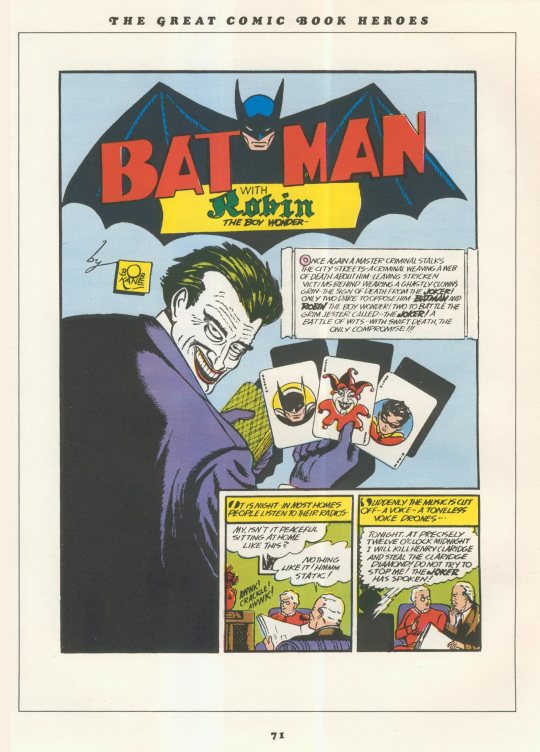
I will confess that, when I first bought this volume, I didn’t read any of Feiffer’s text. That seemed like work to me, who needed it? It was the stories that I was here for! I was hypnotized by the reproduction of one of the comic books that Feiffer had made and sold on the neighborhood street when he was a kid. I had begun to make my own comic books before this, and so this was a very primal point of connection for me–I think I may have read the text of just that one “chapter” (they were all short enough that they were only three or four pages long.)
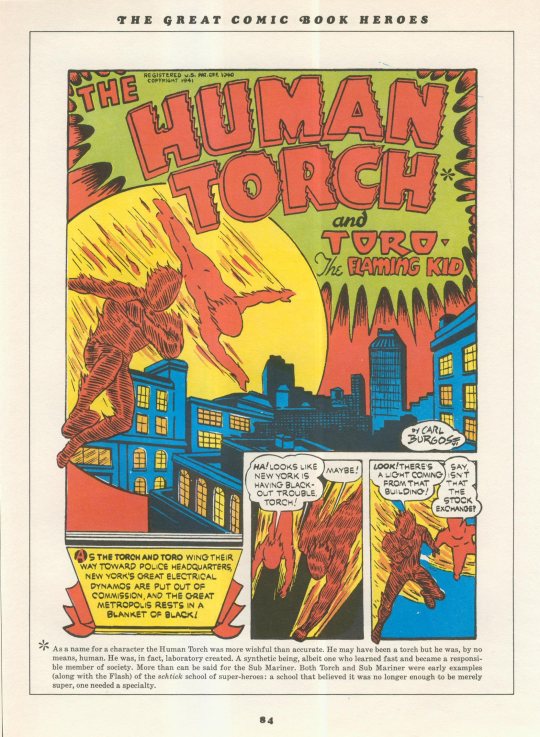
I also didn’t read the stories featuring the Human Torch, the Sub-Mariner and Captain America that were included in the volume. Why would I? I had learned from past experience that I adamantly disliked Marvel comics, decried them whenever I was asked about them, so there was no need to investigate these stories. It would literally be months, not until the summer of 1977, when, on one dull day with nothing better to do, I finally cracked and read through both Feiffer’s full text and the three Marvel stories. And they (along with the write-ups on Timely in the Steranko History of Comics, coming soon) were enough to compel me to give Marvel another chance. But we’ll get to that in due time.
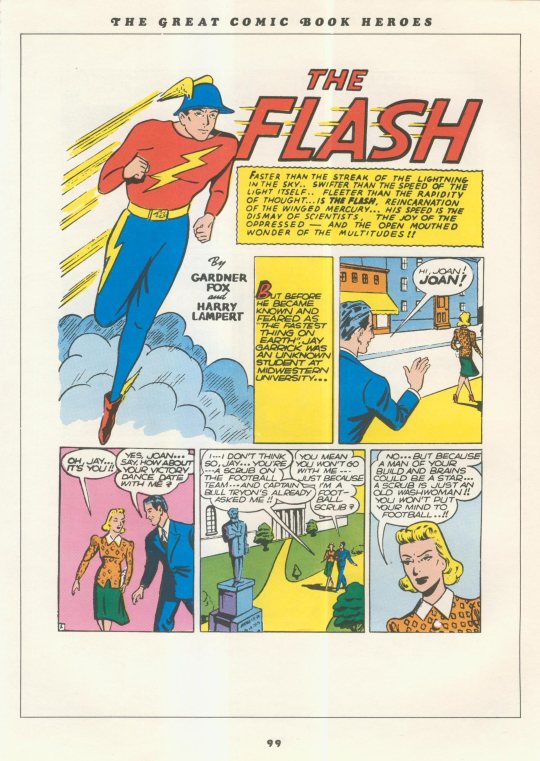
The one disappointing aspect of Feiffer’s book to me, coming to it twelve years later, is that there were already a number of stories in it that I’d read already. Because Feiffer tried to hit all of the mainstays of the big comic book houses in his reprints, and as often as possible, the opening or origin installments. The only times he varied from this approach was when there was some other aspect of the character or the strip that he was trying to highlight–a number of these series took a little while to completely crystallize in their final forms, and Feiffer took that into account when choosing his stories.
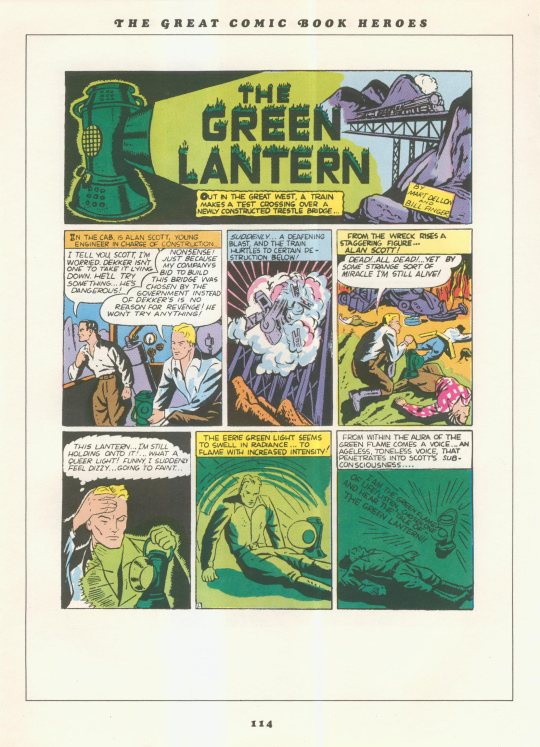
So what was reprinted in this volume? It opened with a two-page origin of Superman, taken not from ACTION COMICS #1 but rather from the more expanded version first shown in SUPERMAN #1. Thereafter, he ran a story that he sourced from SUPERMAN #3 but which was first published in ACTION COMICS #5. It’s really the first full story in which all of the quintessential elements of the Superman series coalesce: the Lois-Clark-Superman relationship in particular. There are several pages in the middle of it that were clearly reworked from newspaper strip samples, panels extended and reformatted into comic book pages haphazardly.

Following the single page of Captain Marvel he could show, Feiffer then reprints the origin of Batman, from BATMAN #1 (which I’d read), as well as the first story featuring the Joker (likewise). This was about a year in, by which point Robin had been introduced, and wit the debut of the Joker all of the elements were in place. But not new to me. Next was a relatively late Human Torch story from MARVEL MYSTERY COMICS #20–like Batman, by this point the Torch’s young partner Toro had come into the series, and it had settled down into typical super-heroics. But I didn’t read it, not yet.

A pair of stories that I’d already experienced came next: the first adventure of the Flash (my third copy of it!) from FLASH COMICS #1 and the first installment of Green lantern from ALL-AMERICAN COMICS #16. Next came a solo Spectre story from ALL-STAR COMICS #1. I was familiar with this early version of the Spectre from the FAMOUS 1st EDITION reprint of ALL-STAR #3, but he wasn’t especially interesting to me. Because he was already dead and could do literally anything, there wasn’t a lot of drama to be found in his stories. Even as a kid, this deficit was apparent to me. Superman, at least, had to struggle to accomplish whatever his goal was.
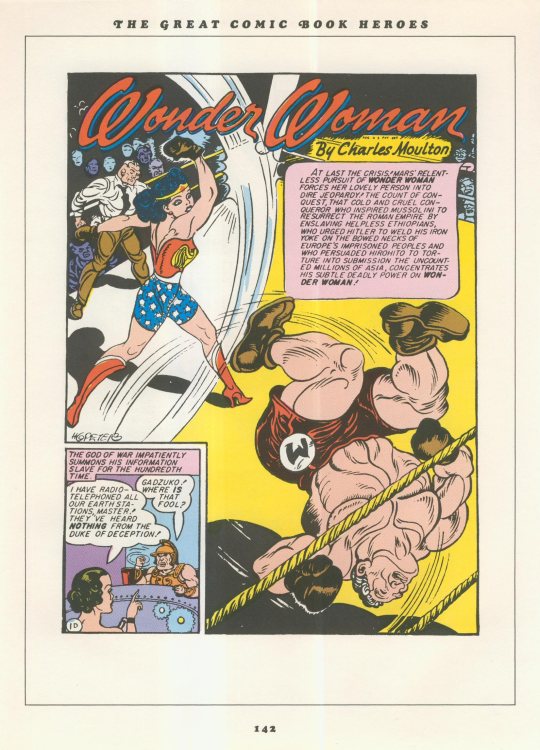
Next came an adventure of Hawkman, sourced from FLASH COMICS #5. Here, Feiffer skipped the earliest adventures of the winged wonder so as to showcase the work of Shelly Moldoff on the strip (and in particular how often he was swiping Flash Gordon panels by Alex Raymond, which happened everywhere.) This was followed by a Wonder Woman story from WONDER WOMAN #2–actually, it was a single chapter of a four-chapter larger story, but I wouldn’t discover this for decades. Feiffer chose it as a good example of some of the strange sexuality that was operating under the hood of what at first glance appeared to be a patriotic heroine series. This was the stuff that really made Wonder Woman sizzle, and the lack of which one of the reasons why her series had such a lack of pop in the 60s and 70s.

Then came a Sub-Mariner adventure from MARVEL MYSTERY COMICS #7, by which point creator Bill Everett had worked out the bugs. I didn’t read it for several months, but essentially it’s an orgy of destruction, as Namor returns to Manhattan to carve out vengeance for his undersea race by wrecking and destroying his way across the city–he even at one point accosts Mayor Fiorello LaGuardia. There isn’t much plot, only carnage–and it ends with Namor’s friend Berry Dean warning him that the Human Torch would be on his trail. But that historic meeting wasn’t included.
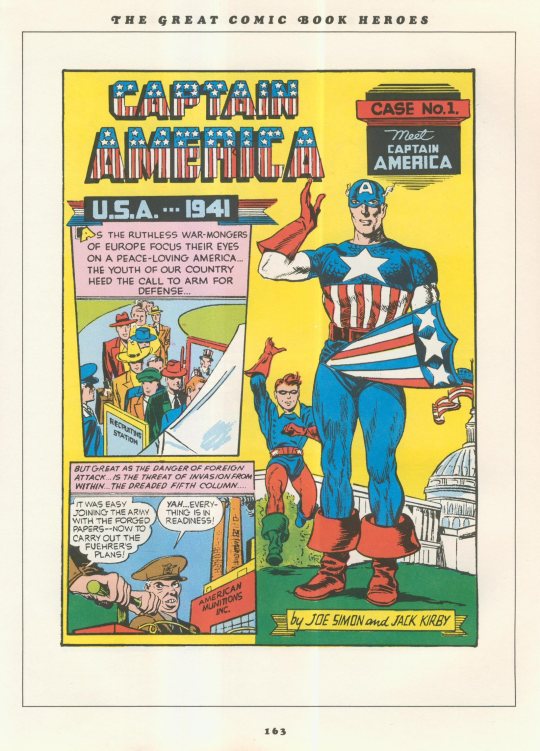
I also skipped the origin of Captain America, from CAPTAIN AMERICA COMICS #1. It’s a pretty crude piece of work, like most of what was reprinted in this volume. There are only hints of the explosiveness that Jack Kirby would bring to the comic book page in the next few issues, to say nothing of the next few decades. The pages were a little bit more jigsaw puzzle-y, but only a little bit. That would change as Kirby got going on Cap.

Next came the first Plastic Man adventure, from POLICE COMICS #1, and which I’d read a few weeks earlier in SECRET ORIGINS OF THE SUPER DC HEROES. It was still a fun tale, but one that only hinted at the inventiveness that Jack Cole would bring to the character and to the page. I felt the same way about the Spirit based on the story that Feiffer reprinted here. He spent a lot of time talking up how innovative and impressive a series it was, but from this sampling, I just couldn’t see it. Part of that, no doubt, is that most scholars consider the best period of Eisner’s Spirit to run from around 1946-1950 or so. But Feiffer was working for Eisner for most of that period–he wrote several of the most memorable tales–and so his interest was in the earliest Spirit adventures, the ones he read as a kid.
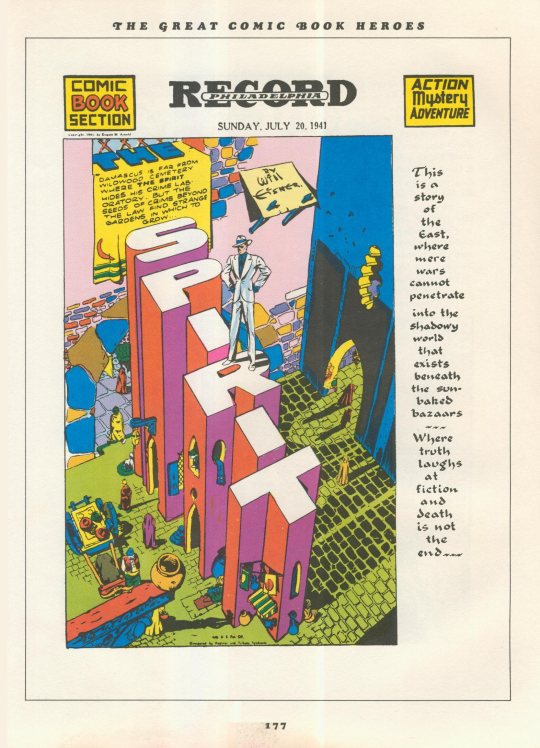
So it was a highly-enjoyable volume, and one that would have a greater impact on me over the course of time, but also slightly disappointing. But I was glad to have it, in particular because its existence came as a total surprise to me. At this point in time, there were precious few compilations of old comic book stories, so each one was like a treasured gem.
Post link

Sub-Mariner #52 (Friedrich/Everett, Aug 1972). Bill Everett’s art evokes Namor’s WW2 era, and the return of his old flame Betty underscores this nostalgia. But recent X-Men foe Sunfire brings about a truly disastrous ending, the likes of which I doubt would’ve been permitted in the ‘40s.

Sub-Mariner #55 (Everett, Nov 1972). Namorita gives her cousin a magic buccaneer’s earring, and Namor wears it when he battles an abominable “snow-king.”

Sub-Mariner #54 (Everett, Oct 1972). The throwback feel of this book is surreal, when compared to the horror or crime titles it shares rack space with.

Sub-Mariner #53 (Everett, Sept 1972). Sunfire and Namor team up to defeat the nationalist Dragon-Lord.
Bill Everett’s Sub-Mariner comics in the 1940s had Namor’s mother as a supporting cast member.
Post link
The Namor the Sub-Mariner 2020 Advent Calendar
Welcome to a Namor Advent Calendar! Have a bit of Namor cheer for each of the 24 days till Christmas! This year I’ll be highlighting Namor Team-Ups!
DAY 23: NAMORA
Another team-up from the Golden Age and another first appearance.

Pay no attention to the Original Human Torch trying to horn in on this team-up on the cover. Jim Hammond doesn’t appear in Namora and Namor’s story.

Golden Age Namor is again very reasonable about his team-ups – just asking him seems to be work most the time.

Namora first appeared late in 1947, and by the Atlas era sadly seems to have taken Lady Dorma’s place as Namor’s Atlantean ‘sidekick.’ But she delivers such classic team-ups as this one, where Namor “infiltrates” a water show and is forced to wear this amazing costume, affectionately known as, “FIN!”
Post link
The Namor the Sub-Mariner 2020 Advent Calendar
Welcome to a Namor Advent Calendar! Have a bit of Namor cheer for each of the 24 days till Christmas! This year I’ll be highlighting Namor Team-Ups!
DAY 24: LADY DORMA
In honor of the upcoming King In Black Namor mini-series by Kurt Busiek, I’m starting with Namor’s very first team-up, in Marvel Comics #1, which was with Lady Dorma!
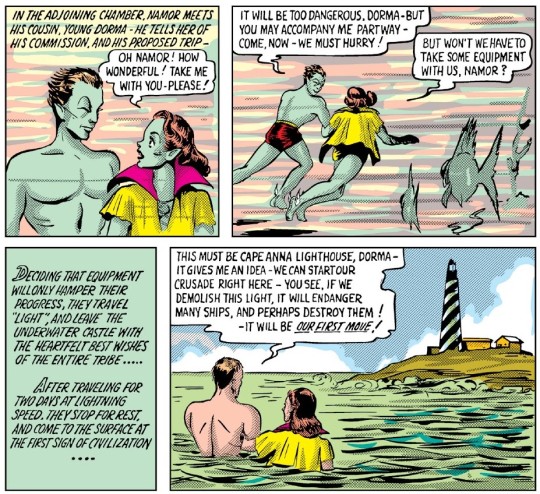
Unlike many future team-ups, this one doesn’t start with Namor fighting with Dorma. Instead, Lady Dorma does what she usually does, i.e. insist on joining Namor on his adventure. The first 8 pages of this story is actually a reprint of Bill Everett’s story for Motion Picture Funnies Weekly #1. Lady Dorma isn’t in those pages, but in the new pages that Bill Everett drew specifically for Marvel Comics #1.
Bonus picture, the original art of the last page of the story, which is also the oldest piece of Marvel art in existence. It also shows Lady Dorma is no shrinking violet, but a capable companion.

Post link
365 Days with Namor
Day 146
“Oh-Oh! What’s this?”
His Highness in swimming trunks, knee high socks, and sporty shirt!
Post link
365 Days with Namor
Day 145
“.. and only you can save the survivors!”
“Bah!”
Of course Namor is the only one who can save them … but of course, he’s going to be grumpy. about it.
Post link
365 Days with Namor
Day 144
“Would you look after my little ‘blitz buggy’?”
I wonder what his Highness named his little flagship?
Post link


